stat946w18/Wavelet Pooling For Convolutional Neural Networks: Difference between revisions
| Line 108: | Line 108: | ||
* '''Backpropagation''' | * '''Backpropagation''' | ||
The proposed wavelet pooling algorithm performs backpropagation by reversing the process of its forward propagation. First, the image feature being backpropagated undergoes 1st order wavelet decomposition. After decomposition, the detail coefficient sub-bands up-sample by a factor of 2 to create a new 1st level decomposition. The initial decomposition then becomes the 2nd level decomposition. Finally, this new 2nd order wavelet decomposition reconstructs the image feature for further backpropagation using the IDWT. | The proposed wavelet pooling algorithm performs backpropagation by reversing the process of its forward propagation. First, the image feature being backpropagated undergoes 1st order wavelet decomposition. After decomposition, the detail coefficient sub-bands up-sample by a factor of 2 to create a new 1st level decomposition. The initial decomposition then becomes the 2nd level decomposition. Finally, this new 2nd order wavelet decomposition reconstructs the image feature for further backpropagation using the IDWT. Figure 5, illustrates the wavelet pooling backpropagation algorithm in details: | ||
[[File:wavelet pooling backpropagation.PNG| 700px|center]] | [[File:wavelet pooling backpropagation.PNG| 700px|center]] | ||
Revision as of 13:05, 3 November 2018
Wavelet Pooling For Convolutional Neural Networks
Your feedback on presentations
Introduction, Important Terms and Brief Summary
This paper focuses on the following important techniques:
1) Convolutional Neural Nets (CNN): These are networks with layered structures that conform to the shape of inputs and consistently obtain high accuracies in the classification of images and objects. Researchers continue to focus on CNN to improve their performances.
2) Pooling: Pooling subsamples the results of the convolution layers and gradually reduces spatial dimensions of the data throughout the network. It is done to reduce parameters, increase computational efficiency and regulate overfitting.
Some of pooling methods, including max pooling and average pooling, are deterministic. This means they are efficient and simple but hinder the potential for optimal network learning. However, mixed pooling and stochastic pooling use probabilistic approach. So, they can address some problems of deterministic methods. Neighborhood approach is used in all the mentioned pooling methods due to simplicity and efficiency. Nevertheless, it suffers from edge halos, blurring, and aliasing which needs to be minimized. This paper introduces wavelet pooling which uses a second-level wavelet decomposition to subsample features. The nearest neighbor interpolation is replaced by an organic, subband method that more accurately represents the feature contents with fewer artifacts. The method decomposes features into a second level decomposition and discards first level subbands to reduce feature dimensions. This method is compared to other state-of-the-art pooling methods to demonstrate superior results. The tests are conducted on benchmark classification tests like MNIST, CIFAR10, SHVN and KDEF.
Intuition
Convolutional networks commonly employ convolutional layers to extract features and use pooling methods for spatial dimensionality reduction. In this study, wavelet pooling is introduced as an alternative to traditional neighborhood pooling by providing a more structural feature dimension reduction method. Max pooling is addressed to have over-fitting problems and average pooling is mentioned to smooth data.
History
A history of different pooling methods have been introduced and referenced in this study:
- manual subsampling at 1979
- Max pooling at 1992
- Mixed pooling at 2014
- pooling methods with probabilistic approaches at 2014 and 2015
Background
Average Pooling and Max Pooling are well known pooling methods and are popular techniques used in the literature. While these methods are simple and effective, they still have some limitations. The authors identify the following limitations:
Limitations of Max Pooling and Average Pooling
Max pooling: takes the maximum value of a region Rij and selects it to obtain a condensed feature map. It can erase the details of the image (happens if the main details have less intensity than the insignificant details) and also commonly over-fits training data. The max-pooling is defined as:
\begin{align} a_{kij} = max_{(p,q)\in R_{ij}}(a_{kpq}) \end{align}
Average pooling: calculates the average value of a region and selects it to obtain a condensed feature map. Depending on the data, this method can dilute pertinent details from an image (happens for data with values much lower than significant details) The avg-pooling is defined as:
\begin{align} a_{kij} = \frac{1}{|R_{ij}|}\sum_{(p,q)\in R_{ij}}{{a_{kpq}}} \end{align}
Where [math]\displaystyle{ a_{kij} }[/math] is the output activation of the [math]\displaystyle{ k^{th} }[/math] feature map at [math]\displaystyle{ (i,j) }[/math], [math]\displaystyle{ a_{kpq} }[/math] is the input activation at [math]\displaystyle{ (p,q) }[/math] within [math]\displaystyle{ R_{ij} }[/math], and [math]\displaystyle{ |R_{ij}| }[/math] is the size of the pooling region. Figure 2 provides an example of the weaknesses of these two methods using toy images:
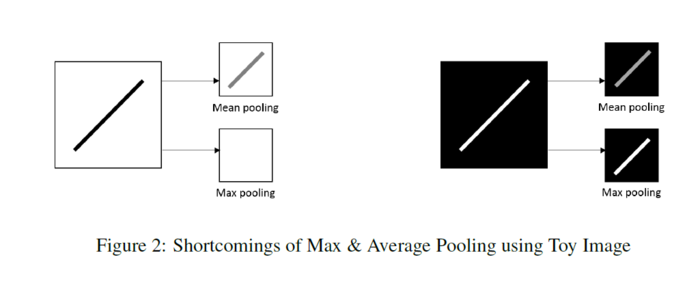
How the researchers try to combat these issues?
Using probabilistic pooling methods such as:
1. Mixed pooling: which combines max and average pooling by randomly selecting one over the other during training in three separate ways:
- For all features within a layer
- Mixed between features within a layer
- Mixed between regions for different features within a layer
Mixed Pooling is defined as:
\begin{align} a_{kij} = \lambda. max_{(p,q)\in R_{ij}}(a_{kpq})+(1-\lambda).\frac{1}{|R_{ij}|}\sum_{(p,q)\in R_{ij}}{{a_{kpq}}} \end{align}
Where [math]\displaystyle{ \lambda }[/math] is a random value 0 or 1, indicating max or average pooling.
2. Stochastic pooling: improves upon max pooling by randomly sampling from neighborhood regions based on the probability values of each activation. This is defined as:
\begin{align} a_{kij} = a_l; where: l\sim P(p_1,p_2,...,p_{|R_{ij}|}) \end{align}
The figure below describes the process of Stochastic Pooling. The figure on the left shows the activations of a given region, and the corresponding probability are shown in the centre. The activations with the highest probability is selected by the pooling method. However, any activation can be selected. In this case, the midrange activation of 13% is selected.
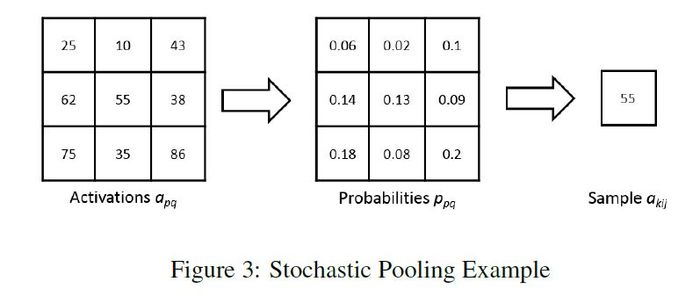
As stochastic pooling is based off of probability, and is not deterministic, it avoids the shortcomings of max and average pooling, and enjoys some of the advantages of max pooling.
Proposed Method
The proposed pooling method uses wavelets to reduce the dimensions of the feature maps. They use wavelet transform to minimize artifacts resulting from neighborhood reduction. They postulate that their approach, which discards the first-order sub-bands, more organically captures the data compression.
- Forward Propagation
The proposed wavelet pooling scheme pools features by performing a 2nd order decomposition in the wavelet domain according to the fast wavelet transform (FWT) which is a more efficient implementation of the two-dimensional discrete wavelet transform (DWT) as follows:
\begin{align} W_{\varphi}[j+1,k] = h_{\varphi}[-n]*W_{\varphi}[j,n]|_{n=2k,k\leq0} \end{align}
\begin{align} W_{\psi}[j+1,k] = h_{\psi}[-n]*W_{\psi}[j,n]|_{n=2k,k\leq0} \end{align}
where [math]\displaystyle{ \varphi }[/math] is the approximation function, and [math]\displaystyle{ \psi }[/math] is the detail function, [math]\displaystyle{ W_{\varphi},W_{\psi} }[/math] are called approximation and detail coefficients. [math]\displaystyle{ h_{\varphi[-n]} }[/math] and [math]\displaystyle{ h_{\psi[-n]} }[/math] are the time reversed scaling and wavelet vectors, (n) represents the sample in the vector, while (j) denotes the resolution level
When using the FWT on images, it is applied twice (once on the rows, then again on the columns). By doing this in combination, the detail sub-bands (LH, HL, HH) at each decomposition level, and approximation sub-band (LL) for the highest decomposition level is obtained. After performing the 2nd order decomposition, the image features are reconstructed, but only using the 2nd order wavelet sub-bands. This method pools the image features by a factor of 2 using the inverse FWT (IFWT) which is based off the inverse DWT (IDWT).
\begin{align} W_{\varphi}[j,k] = h_{\varphi}[-n]*W_{\varphi}[j+1,n]+h_{\psi}[-n]*W_{\psi}[j+1,n]|_{n=\frac{k}{2},k\leq0} \end{align}
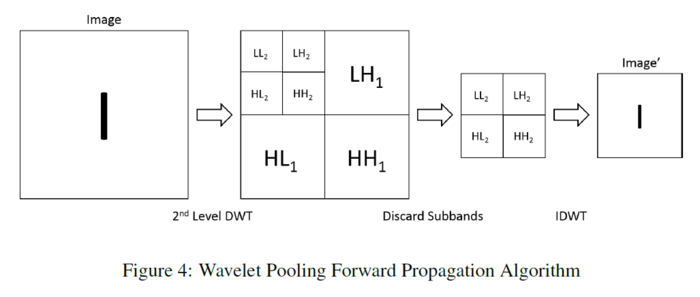
- Backpropagation
The proposed wavelet pooling algorithm performs backpropagation by reversing the process of its forward propagation. First, the image feature being backpropagated undergoes 1st order wavelet decomposition. After decomposition, the detail coefficient sub-bands up-sample by a factor of 2 to create a new 1st level decomposition. The initial decomposition then becomes the 2nd level decomposition. Finally, this new 2nd order wavelet decomposition reconstructs the image feature for further backpropagation using the IDWT. Figure 5, illustrates the wavelet pooling backpropagation algorithm in details:
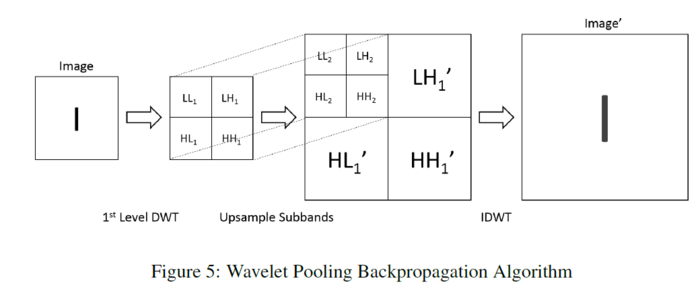
Results and Discussion
All experiments have been performed using the MatConvNet architecture. Stochastic gradient descent has been used for training. For the proposed method, the Haar wavelet has been chosen as the basis wavelet for its property of having even, square sub-bands. The authors have tested the proposed method on four different datasets as shown in the figure:
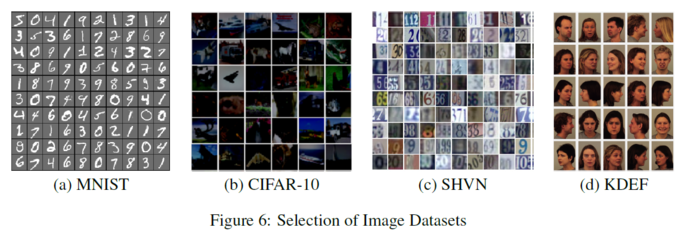
Different methods based on Max, Average, Mixed, Stochastic and Wavelet have been used at the pooling section of each architecture. Accuracy and Model Energy have been used as the metrics to evaluate the performance of the proposed methods. These have been evaluated and their performances have been compared on different data-sets.
- MNIST:
The network architecture is based on the example MNIST structure from MatConvNet, with batch-normalization, inserted. All other parameters are the same. The figure below shows their network structure for the MNIST experiments.
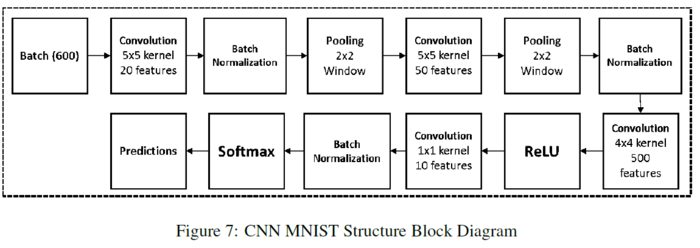
The input training data and test data come from the MNIST database of handwritten digits. The full training set of 60,000 images is used, as well as the full testing set of 10,000 images. The table below shows their proposed method outperforms all methods. Given the small number of epochs, max pooling is the only method to start to over-fit the data during training. Mixed and stochastic pooling show a rocky trajectory but do not over-fit. Average and wavelet pooling show a smoother descent in learning and error reduction. The figure below shows the energy of each method per epoch.
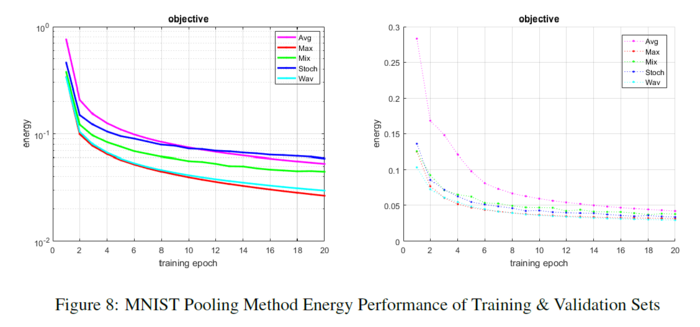
The accuracies for both paradigms are shown below:

- CIFAR:
The authors perform two sets of experiments with the pooling methods. The first is a regular network structure with no dropout layers. They use this network to observe each pooling method without extra regularization. The second uses dropout and batch normalization and performs over 30 more epochs to observe the effects of these changes.
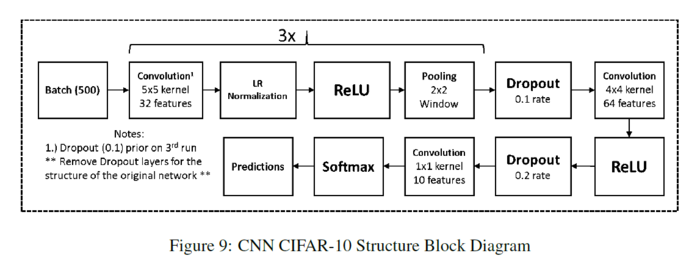
The input training and test data come from the CIFAR-10 dataset. The full training set of 50,000 images is used, as well as the full testing set of 10,000 images. For both cases, with no dropout, and with dropout, Tables below show that the proposed method has the second highest accuracy.
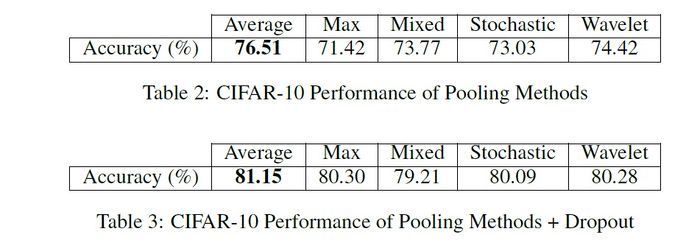
Max pooling over-fits fairly quickly, while wavelet pooling resists over-fitting. The change in learning rate prevents their method from over-fitting, and it continues to show a slower propensity for learning. Mixed and stochastic pooling maintain a consistent progression of learning, and their validation sets trend at a similar, but better rate than their proposed method. Average pooling shows the smoothest descent in learning and error reduction, especially in the validation set. The energy of each method per epoch is also shown below:
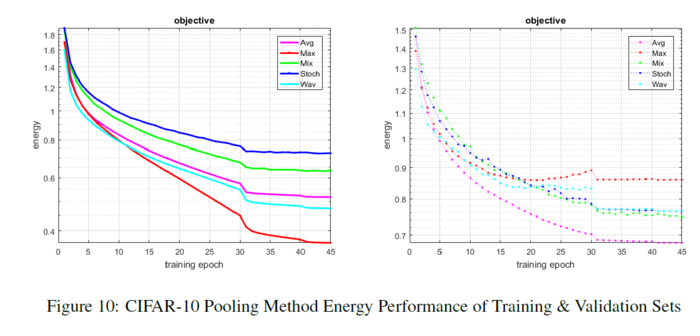
- SHVN:
Two sets of experiments are performed with the pooling methods. The first is a regular network structure with no dropout layers. They use this network to observe each pooling method without extra regularization same as what happened in the previous datasets. The second network uses dropout to observe the effects of this change. The figure below shows their network structure for the SHVN experiments:
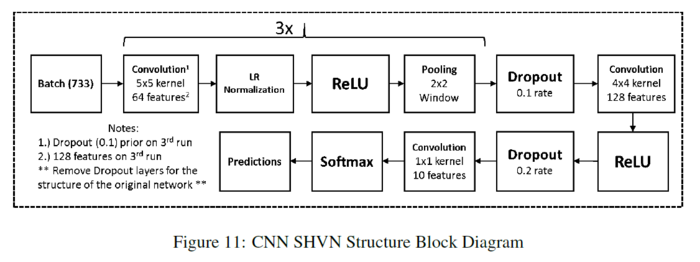
The input training and test data come from the SHVN dataset. For the case with no dropout, they use 55,000 images from the training set. For the case with dropout, they use the full training set of 73,257 images, a validation set of 30,000 images they extract from the extra training set of 531,131 images, as well as the full testing set of 26,032 images. For both cases, with no dropout, and with dropout, Tables below show their proposed method has the second lowest accuracy.
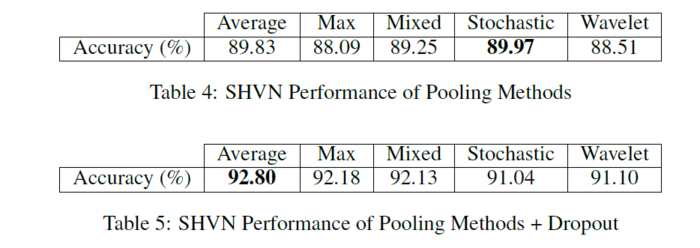
Max and wavelet pooling both slightly over-fit the data. Their method follows the path of max pooling but performs slightly better in maintaining some stability. Mixed, stochastic, and average pooling maintain a slow progression of learning, and their validation sets trend at near identical rates. The figure below shows the energy of each method per epoch.
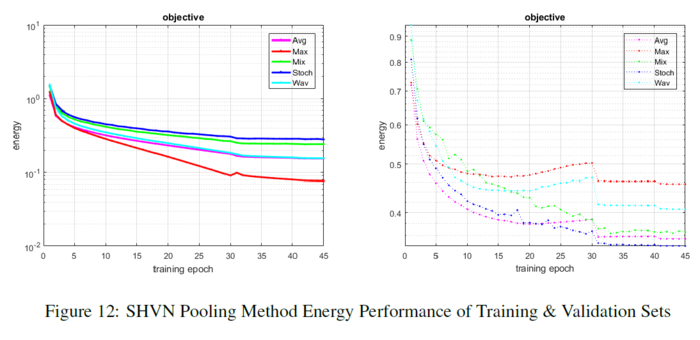
- KDEF:
They run one set of experiments with the pooling methods that includes dropout. The figure below shows their network structure for the KDEF experiments:
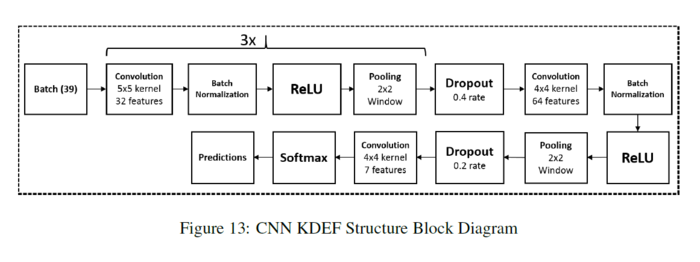
The input training and test data come from the KDEF dataset. This dataset contains 4,900 images of 35 people displaying seven basic emotions (afraid, angry, disgusted, happy, neutral, sad, and surprised) using facial expressions. They display emotions at five poses (full left and right profiles, half left and right profiles, and straight).
This dataset contains a few errors that they have fixed (missing or corrupted images, uncropped images, etc.). All of the missing images are at angles of -90, -45, 45, or 90 degrees. They fix the missing and corrupt images by mirroring their counterparts in MATLAB and adding them back to the dataset. They manually crop the images that need to match the dimensions set by the creators (762 x 562). KDEF does not designate a training or test data set. They shuffle the data and separate 3,900 images as training data, and 1,000 images as test data. They resize the images to 128x128 because of memory and time constraints.
The dropout layers regulate the network and maintain stability in spite of some pooling methods known to over-fit. The table below shows their proposed method has the second highest accuracy. Max pooling eventually over-fits, while wavelet pooling resists over-fitting. Average and mixed pooling resist over-fitting but are unstable for most of the learning. Stochastic pooling maintains a consistent progression of learning. Wavelet pooling also follows a smoother, consistent progression of learning. The figure below shows the energy of each method per epoch.
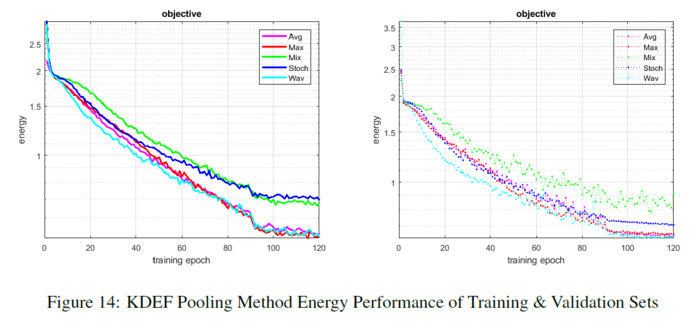
The accuracies for both paradigms are shown below:

Conclusion
They prove wavelet pooling has the potential to equal or eclipse some of the traditional methods currently utilized in CNNs. Their proposed method outperforms all others in the MNIST dataset, outperforms all but one in the CIFAR-10 and KDEF datasets, and performs within respectable ranges of the pooling methods that outdo it in the SHVN dataset. The addition of dropout and batch normalization show their proposed methods response to network regularization. Like the non-dropout cases, it outperforms all but one in both the CIFAR-10 & KDEF datasets and performs within respectable ranges of the pooling methods that outdo it in the SHVN dataset.
Suggested Future work
Upsampling and downsampling factors in decomposition and reconstruction needs to be changed to achieve more feature reduction. The subbands that we previously discard should be kept for higher accuracies.
Critiques and Suggestions
- The functionality of backpropagation process which can be a positive point of the study is not described enough comparing to the existing methods.
- The main study is on wavelet decomposition while the reason of using Haar as mother wavelet and the number of decomposition levels selection has not been described and are just mentioned as a future study!
- At the beginning, the study mentions that the pooling method is not under attention as it should be. In the end, results show that choosing the pooling method depends on the dataset and they mention trial and test as a reasonable approach to choose the pooling method. In my point of view, the authors have not really been focused on providing a pooling method which can help the current conditions to be improved effectively. At least, trying to extract a better pattern for relating results to the dataset structure could be so helpful.
- Average pooling origins which are mentioned as the main pooling algorithm to compare with, is not even referenced in the introduction.
- Combination of the wavelet, Max and Average pooling can be an interesting option to investigate more on this topic; both in a row(Max/Avg after wavelet pooling) and combined like mix pooling option.
References
Williams, Travis, and Robert Li. "Wavelet Pooling for Convolutional Neural Networks." (2018).